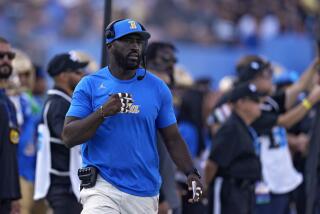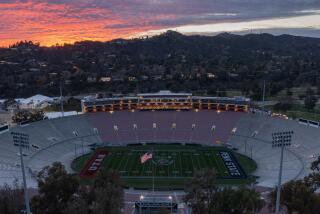A Crazy Eight Is Too Much for One TV Screen : College football: The overabundance of bowl games on New Yearâs Day makes it impossible to watch them all. Who came up with this system?
Inspecting the bowl football program on New Yearâs Day, you have a vision of herring in a net, flopping over one another.
The current lineup embraces eight games, running from 8:30 in the morning (PST) until roughly 8:30 at night.
You are surprised the genii of college football have stopped at eight games. Between midnight and 8 a.m., they could book two more.
And, of course, they could squeeze in another in prime time.
Right now, they have arranged so many games Jan. 1 that an overlap occurs. For instance, the Citrus Bowl, the Cotton Bowl and the Hall of Fame Bowl poach on each otherâs telecast.
And all three arrive on the air at some time during the second half of the Gator Bowl.
The Orange Bowl and the Sugar Bowl overlap, same as the Fiesta Bowl and the Rose Bowl. And all are coming off a previous day of activity featuring the John Hancock Bowl and the Dominoâs Pizza Copper Bowl.
A confused viewer of those two could leave his set believing he will be insured in 30 minutes, or the policy is free.
You are a tolerant individual. You are patient and understanding, the milk of human kindness flowing by the liter through every vein.
You are not aiming to rock the vessel. All you are trying to comprehend is whether college football has gone foaming-at-the-mouth mad.
One isnât supposed to be dealing here with dummies. This is our highest intellectual order, the teachers of our young.
And they allow a circumstance on New Yearâs Day calling for eight televised bowl games?
If smart guys permit this excess, what would imbeciles do?
So what has all this done to that spectacle billing itself as âthe Granddaddy of âEm All,â the Rose Bowl?
What it has done is reduce the Rose Bowl to selling nothing but age--a game beginning in 1902 and continuing to the present, with intermittent stoppages.
After the 1902 game, for instance, it stopped until 1916, substituting that well-known ghetto sport, polo. It also tried chariot races.
And then the Rose Bowl ground to a halt in Pasadena in 1942 when the game was shifted to Durham, N.C. It was a war year, and Pasadena feared an air attack by the Japanese.
What an insult to the Luftwaffe to OK the game on the East Coast.
Although it was once the premier postseason game, the Rose Bowl has suffered serious slippage, not at the box office, but in the television ratings and in general prestige.
And the ultimate contempt has been the willingness of other bowls to go head-and-head with it on TV.
Offering Washington and Iowa this time, the Rose Bowl neednât necessarily apologize. Washington, on a good day, can knock off any amateur team in the hemisphere.
And Iowa is better than average.
But it has become increasingly rare that connoisseurs about the land judge the Rose Bowl as an event of major national impact. It is more a parochial little war between the Pacific 10 and the Big Ten, pretty much like Eton and Harrow.
Since the Rose Bowl still dredges more money from television than any other bowl game--that could be a fleeting condition--it behooves the promoters each year to capture participants of muscle, teams with substantial followings.
Those teams preferred are USC, UCLA, Michigan and Ohio State.
Washington and Iowa are rated fair. What ABC lives in fear of is, say, Oregon State vs. Indiana.
Bucking seven other games New Yearâs Day, with such a matchup the network starts looking for a bridge.
One is available in Pasadena, making the Rose Bowl a game of convenience, if nothing else.
More to Read
Go beyond the scoreboard
Get the latest on L.A.'s teams in the daily Sports Report newsletter.
You may occasionally receive promotional content from the Los Angeles Times.










